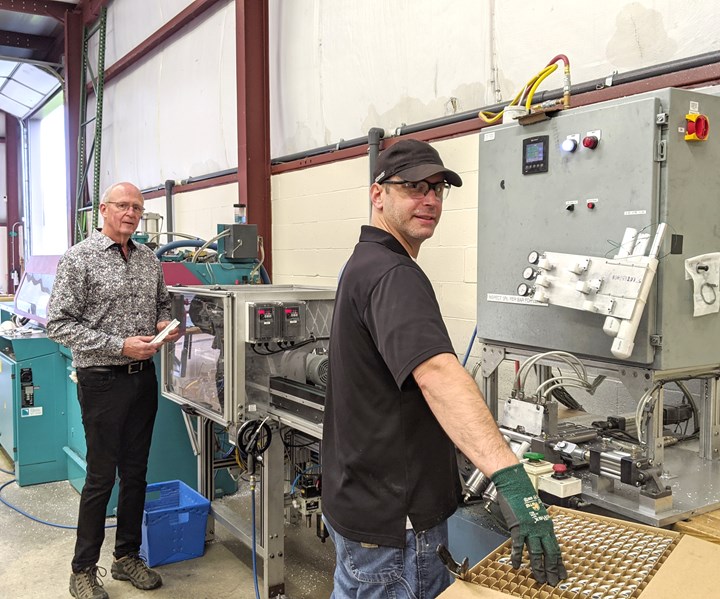
Anthony Staub
Founder, Staub Precision Machine
One of the most thrilling aspects of my job has been that as I walk into our plant each day, I have no idea what problem or challenge will be put before me. Some are mundane, some are impossibly difficult. There are often many different solutions to every problem — some are better than others, but in most cases there is no absolutely correct answer. In thinking about this idea, I wanted to share a situation in which we were faced with a challenge and needed to think outside the box to come up with the best solution.
A good customer came to us with a new opportunity: We needed to drill and countersink four holes in a custom-shaped aluminum extrusion. The extrusions would be supplied to us cut to 6-, 8- and 11-inch lengths, having been deburred on both ends. Annual quantity would be approximately 500,000 pieces. Staub Precision Machine may be a high-end production manufacturer with some of the latest automation equipment, multi-axis lathes, four-axis HMCs and five-axis machines processing sophisticated parts; but initially, we could not find a way to meet the output requirements while meeting cost requirements.
We are excellent with aluminum, and our HMCs would eat this job up. Our normal plan of attack would be to put as many parts as possible on a tombstone and drill away. A tombstone with 64 parts would be done in a flash — we estimated 8 ½ minutes. The load/unload cycle time of each tombstone would be 12 minutes. That is fast, but even with two tombstones, the machine would sit for at least 3 ½ minutes between cycles, and it would require 31 cycles to reach our goal of 2,000 pieces per day.
We would need to be flexible. It was clear to me that our normal approach wasn’t going to work. Because our roots are as a production machine shop, we tend first to look at parts from an automated CNC machining standpoint. Flexible manufacturing systems, pallets, tombstones and robots are typical tools that we pair with our CNC mills and lathes, but they wouldn’t help us with this problem. We decided that this challenge needed a custom solution, and we went down a path that was different from our typical processes.

Tony Staub and operator Joe Regan stand with the inline saw-deburr-machining process used in Staub Precision Machine’s nontraditional approach to a challenging machining project.
Our team decided to design and build a special drilling machine. We mounted four electrically driven spindles on a moving slide and drove them with a servo motor. We used a variety of air cylinders to locate and securely clamp the part, paying particular attention to the datums. We used a programmable logic controller (PLC) to control the clamps and the drilling process. We used minimum-quantity lubrication (MQL) on combined drill and countersink tools. Using this method, we were able to bring our cycle time down to 6 seconds per part, and over time we were able to reach 4,000 pieces per day (twice our requirement). That put us in control of our schedule, freed up a horizontal machining center and eliminated the need for pallets, tombstones and machine time.
In addition to drilling, the customer asked us to look at cutting and deburring the blanks. The only way it made sense for us was to cut, deburr and present the blanks automatically to the drilling operator. Our approach was to marry a cold saw and an automatic deburring station to the drilling machine. We purchased a high-end automatic cold saw and developed an automatic deburring station. After a precise saw cut, we use a conveyor to transport the extrusions to the deburring station. The part is clamped in non-marring jaws as it is moved back and forth past a set of cup-type brushes filled with highly abrasive nylon. The part is then released onto another conveyor where it is picked up by an operator and placed in the drilling operation. Cutting, deburring and delivery happen during the drilling cycle, so the operator has enough time to drill, inspect and box the hinges.
A simple challenge led us to a very unique manufacturing process. One takeaway is that not every job needs sophisticated and expensive CNC equipment. If we tried to apply our typical tools and processes to every problem, we would be missing plenty of viable opportunities with good customers. This project reminded us that we can be most successful by thinking about our problems with an open mind. We really tried to put this job on an HMC, but were more successful taking a different approach. We know how valuable our CNC machines are and how we have come to depend on them daily. But we were again reminded that they are not always the answer to our challenges.
RELATED CONTENT
July 15, 2020 at 11:16AM
https://ift.tt/2B1YnhZ
When Sophisticated CNC Machine Tools Aren't the Best Answer - Modern Machine Shop
https://ift.tt/2WinW4G
Bagikan Berita Ini


.jpg;width=70;height=70;mode=crop)















0 Response to "When Sophisticated CNC Machine Tools Aren't the Best Answer - Modern Machine Shop"
Post a Comment